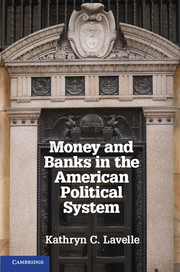Book contents
- Frontmatter
- Contents
- Figures and Tables
- Preface
- Acknowledgments
- Abbreviations
- 1 The Institutional Foundations of Financial Politics in the United States
- Section 1 A Historical Background
- Section 2 Bureaucratic Politics and Finance
- 4 Making Financial Policy in Congress
- 5 Making Financial Policy in the Executive Branch and the Federal Bureaucracy
- 6 Making Financial Policy in the Federal Reserve System
- Section 3 The Operation of the Financial Political Economy
- Section 4 Conclusions
- Glossary
- References
- Index
- References
5 - Making Financial Policy in the Executive Branch and the Federal Bureaucracy
Published online by Cambridge University Press: 05 January 2013
- Frontmatter
- Contents
- Figures and Tables
- Preface
- Acknowledgments
- Abbreviations
- 1 The Institutional Foundations of Financial Politics in the United States
- Section 1 A Historical Background
- Section 2 Bureaucratic Politics and Finance
- 4 Making Financial Policy in Congress
- 5 Making Financial Policy in the Executive Branch and the Federal Bureaucracy
- 6 Making Financial Policy in the Federal Reserve System
- Section 3 The Operation of the Financial Political Economy
- Section 4 Conclusions
- Glossary
- References
- Index
- References
Summary
Students of American government learn that the president controls the executive branch. After all, the president is the titular head of the executive branch of government and the only individual elected by all of the American people. However, those working in government know that the reality is much more complex. The president has three main levers of control over the bureaucracy, but as Chapter 4's discussion on the legislature demonstrated, none is absolute. He can make appointments to the top layer of management at each, but these appointments must be confirmed by the Senate. He can try to reorganize the bureaucracy, but these maneuvers are resisted by congressional committees who would then be subject to shifting jurisdictions. He can issue executive orders – that is, presidential directives to agencies – and leave himself open to criticism that the action is autocratic. In the most extreme cases, Congress can overturn an executive order with legislation or refuse to provide the necessary funding for it.
This chapter explores the connection between presidential administrations and agencies in the monetary, fiscal, and regulatory policy realms. The connection poses a unique problem in the financial area because any administration's ability to control the myriad agencies that regulate and manage the financial system varies dramatically according to how their governance structures were arranged when they were established and the organizational characteristics they have developed since then. Moreover, the agencies themselves operate within the same complex system of conflicting jurisdictions and mandates as the congressional committees. It gives each of them their own interests in preserving their areas of competence and authority, as well as an inherent tension among them. The result is that once Congress passes legislation, the contest over policy moves to the administrative agencies through the rulemaking process; if it is not satisfactory, it moves back to Congress or to the courts. Disputes over policy therefore occur in a variety of locations, with interest groups trying to gain an advantage each step of the way.
- Type
- Chapter
- Information
- Money and Banks in the American Political System , pp. 108 - 134Publisher: Cambridge University PressPrint publication year: 2013

